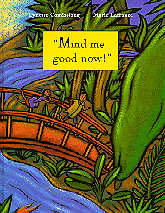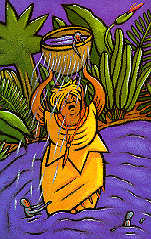


|
Mind Me Good Now!
Lynette Comissiong. Illustrated by Marie Lafrance.
Grades 3 - 6 / Ages 8 - 11.
** /4
|

 In this Caribbean Hansel and Gretel-type story, siblings Dalby and Tina are warned repeatedly not to go near the bridge. One day, after selling their eggs at the market, the children yield to temptation and cross the bridge. They see a house on the top of a faraway hill, and, drawn toward the house like magnets, the children follow the path leading to it. Approaching cautiously, they see a spinning ball of fire at the window. Mama Zee appears at the door and invites the children to come inside for dinner.
In this Caribbean Hansel and Gretel-type story, siblings Dalby and Tina are warned repeatedly not to go near the bridge. One day, after selling their eggs at the market, the children yield to temptation and cross the bridge. They see a house on the top of a faraway hill, and, drawn toward the house like magnets, the children follow the path leading to it. Approaching cautiously, they see a spinning ball of fire at the window. Mama Zee appears at the door and invites the children to come inside for dinner.
The children spend the night, but, in the morning, they find Mama Zee gone and all the doors and windows locked. They think that Mama Zee must be a "cocoya" - a spirit capable of changing shape - that only comes out at night and shrivels up and blows away in the sunlight. That night they see the fireball again and hear a voice singing:
Ball of fire, spin me round,
I'm a Cocoya, put me down,
Mama Zee, Mama Zee, is my name,
My cousin Soucouyant has more fame,
Little boys, mmm! They taste so nice,
Boil them up with sugar and spice.
When Mama Zee sharpens her machete, Tina, afraid for her brother, springs into action. Tina remembers that, according to her Papa's stories, cocoyas will do anything for little girls, so she asks Mama Zee to perform several time-consuming tasks, such as preparing a special bedtime snack, to keep her from harming Dalby. As morning approaches, Tina asks Mama Zee to bathe her in river water. Mama Zee fills her basket at the river, but the water keeps leaking out. In her frustration, she does not notice that the sun is rising. She shrivels up, never to be seen again.
Comissiong captures the flavour of the Caribbean culture by incorporating a Jamaican dialect in the story. The text on at least half of the pages is very distracting, however, as it changes size in certain phrases and sentences which the author wants to emphasize for dramatic value.
Lafrance's simple illustrations, rendered in acrylics, are done in the bright colours of the Caribbean islands. Though Mama Zee's words and actions make her a sinister figure, in some illustrations she bears a striking resemblance to Wilma Flintstone, and therefore, is a little harder to take seriously.
Even though this story is derived from Caribbean folklore, its implied violence might be too scary for younger children. .
Recommended with reservations
Gail Hamilton is a teacher-librarian at Bird's Hill School, Winnipeg, Manitoba.

To comment on this title or this review, send mail to cm@umanitoba.ca.
Copyright © 1997 the Manitoba Library Association. Reproduction for personal use is permitted only if this copyright notice is maintained. Any other reproduction is prohibited without permission.
Published by
The Manitoba Library Association
ISSN 1201-9364
TABLE OF CONTENTS FOR THIS ISSUE - NOVEMBER 28, 1997.
AUTHORS | TITLES | MEDIA REVIEWS | BOOKSHELF | BACK ISSUES | SEARCH | CMARCHIVE | HOME